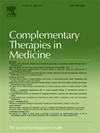Effects and safety of the traditional Chinese exercise baduanjin on depression and anxiety in COVID-19 patients: A systematic review and meta-analysis
IF 3.3
3区 医学
Q1 INTEGRATIVE & COMPLEMENTARY MEDICINE
引用次数: 0
Abstract
Aim
This systematic review and meta-analysis aimed to assess the safety and efficacy of Baduanjin, a traditional Chinese exercise (TCM), for reducing depression and anxiety in individuals suffering from coronavirus disease 2019 (COVID-19).
Methods
Nineteen databases were searched from their inception through August 2024 to gather data for this study. The focus of this study was randomized controlled trials (RCTs) in which Baduanjin was administered for the treatment of COVID-19 patients with depression and anxiety. The study included various types of Baduanjin exercise, whether used alone or in conjunction with other treatment modalities, for the control group. The comparators included a waitlist control, usual care, health education and supportive counseling, psychosocial support therapy, pharmacotherapies, and other common exercises. The exclusion criteria for trials were trials comparing different treatment durations, different treatment frequencies, and different types of Baduanjin exercise. Moreover, other traditional Chinese medicine (TCM) therapeutic methods applied in either the intervention or control group were also excluded. Throughout the entire study, the selection process, data extraction and quantitative analysis were carried out in strict adherence to all relevant guidelines. The Cochrane criteria for risk of bias were used to assess the methodological quality of the trials. In our review, a meta-analysis was performed using the software STATA MP14.
Results
After conducting a meta-analysis, eight RCTs were found to have satisfied the inclusion criteria. The effects of Baduanjin exercise on self-rating anxiety scale (SAS) scores were investigated in five RCTs comprising a total of 228 patients. Analysis of the results revealed that the combination of Baduanjin exercises and conventional therapies led to a statistically significant reduction in SAS scores [MD=-3.21 (95 % CI= −3.64, −2.79), P< 0.001] compared to conventional therapies alone. Moreover, this systematic review explored the effect of Baduanjin exercise on self-rating depression scale (SDS) scores (three RCTs involving 83 participants), Hamilton Anxiety Rating Scale (HAM-A) scores (one RCT involving 103 participants), Patient Health Questionnaire (PHQ-9) scores (one RCT involving 70 participants) and Generalized Anxiety Disorder-7 (GAD-7) scores (one RCT involving 59 participants) for patients with COVID-19. The results showed that, in addition to conventional therapies, Baduanjin exercise had a more favorable impact on reducing the SDS score [mean difference (MD) =-2.86 (95 % CI=4.11, −1.61), P=0.025], PHQ-9 score [MD=-5.31, 95 % CI=-8.73, −1.89), P=0.002] and HAM-A score [MD=-3.00, 95 % CI=-5.33, −0.67], P=0.010] in patients with COVID-19 than did the use of conventional therapies alone. Furthermore, the combination of Baduanjin exercise and conventional therapies effectively decreased the number of patients who experienced severe or moderate anxiety according to the GAD-7 score compared to that of patients who experienced severe or moderate anxiety according to conventional therapies alone [Relative Risk (RR) =0.03, 95 % CI=0.00, 0.51); P=0.020]. However, the included clinical trials lacked a detailed description of the randomization process, and only a small portion of the studies reported proper allocation concealment procedures, which may introduce selection bias. Moreover, owing to the nature of Baduanjin exercise, it is difficult to blind participants and practitioners, which may lead to performance bias. Furthermore, the lack of blinding may lead to subjective influences of assessors on the results, thereby causing detection bias. These methodological shortcomings and potential biases should be addressed in future studies.
Conclusions
It is difficult to draw firm conclusions on whether Baduanjin exercise is an effective intervention for reducing depression and anxiety in COVID-19 patients because of the high risk of bias among the available RCTs. Further rigorous RCTs are warranted but need to overcome the methodological shortcomings of the existing evidence.
中国传统运动八段锦对 COVID-19 患者抑郁和焦虑的影响及安全性:系统回顾与荟萃分析
目的本系统综述和荟萃分析旨在评估八段锦(一种传统中药)对减轻2019年冠状病毒病(COVID-19)患者抑郁和焦虑的安全性和有效性。方法为了收集本研究的数据,检索了19个从开始到2024年8月的数据库。本研究的重点是使用巴杜安金治疗 COVID-19 抑郁症和焦虑症患者的随机对照试验(RCT)。研究包括各种类型的八段锦锻炼,无论是单独使用还是与其他治疗方式结合使用,对照组均为八段锦锻炼。比较组包括候补对照组、常规护理组、健康教育和支持性咨询组、社会心理支持疗法组、药物疗法组和其他常见运动组。排除试验的标准是比较不同的治疗时间、不同的治疗频率和不同类型的八段锦运动。此外,在干预组或对照组中应用的其他传统中医治疗方法也被排除在外。在整个研究过程中,选择过程、数据提取和定量分析都严格遵守了所有相关准则。在评估试验的方法学质量时,采用了 Cochrane 的偏倚风险标准。在我们的综述中,使用 STATA MP14 软件进行了荟萃分析。结果在进行荟萃分析后,发现有 8 项研究符合纳入标准。五项研究共纳入 228 名患者,研究了八段锦运动对焦虑自评量表(SAS)评分的影响。结果分析表明,与单独使用传统疗法相比,八段锦运动与传统疗法相结合可使 SAS 评分显著降低[MD=-3.21 (95 % CI= -3.64, -2.79),P< 0.001]。此外,本系统综述还探讨了八段锦运动对 COVID-19 患者的抑郁自评量表(SDS)评分(3 项研究,83 人参与)、汉密尔顿焦虑评分量表(HAM-A)评分(1 项研究,103 人参与)、患者健康问卷(PHQ-9)评分(1 项研究,70 人参与)和广泛性焦虑症-7(GAD-7)评分(1 项研究,59 人参与)的影响。结果显示,除常规疗法外,八段锦运动对降低 SDS 评分[平均差(MD)=-2.86(95 % CI=4.11,-1.61),P=0.025]、PHQ-9 评分[MD=-5.31,95 % CI=-8.73,-1.89),P=0.002]和 HAM-A 评分[MD=-3.00,95 % CI=-5.33,-0.67],P=0.010]。此外,与单独使用常规疗法相比,将八段锦运动与常规疗法相结合可有效减少根据 GAD-7 评分出现严重或中度焦虑的患者人数[相对风险(RR)=0.03,95 % CI=0.00,0.51];P=0.020]。然而,所纳入的临床试验缺乏对随机化过程的详细描述,只有一小部分研究报告了适当的分配隐藏程序,这可能会带来选择偏倚。此外,由于八段锦运动的性质,很难对参与者和练习者进行盲法操作,这可能会导致表现偏差。此外,缺乏盲法可能导致评估者主观影响结果,从而造成检测偏差。结论 由于现有的 RCT 存在较高的偏倚风险,因此很难就八段锦运动是否是减少 COVID-19 患者抑郁和焦虑的有效干预措施得出确切结论。有必要进一步开展严格的 RCT 研究,但需要克服现有证据在方法上的不足。
本文章由计算机程序翻译,如有差异,请以英文原文为准。
求助全文
约1分钟内获得全文
求助全文
来源期刊

Complementary therapies in medicine
医学-全科医学与补充医学
CiteScore
8.60
自引率
2.80%
发文量
101
审稿时长
112 days
期刊介绍:
Complementary Therapies in Medicine is an international, peer-reviewed journal that has considerable appeal to anyone who seeks objective and critical information on complementary therapies or who wishes to deepen their understanding of these approaches. It will be of particular interest to healthcare practitioners including family practitioners, complementary therapists, nurses, and physiotherapists; to academics including social scientists and CAM researchers; to healthcare managers; and to patients. Complementary Therapies in Medicine aims to publish valid, relevant and rigorous research and serious discussion articles with the main purpose of improving healthcare.
 求助内容:
求助内容: 应助结果提醒方式:
应助结果提醒方式:


